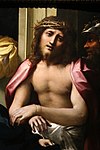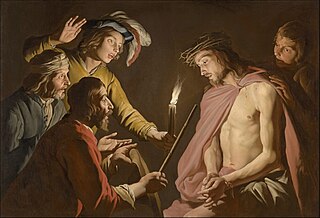
The Passion is the short final period before the death of Jesus, described in the four canonical gospels. It is commemorated in Christianity every year during Holy Week.

Ecce homo are the Latin words used by Pontius Pilate in the Vulgate translation of the Gospel of John, when he presents a scourged Jesus, bound and crowned with thorns, to a hostile crowd shortly before his Crucifixion. The original New Testament Greek: "ἰδοὺ ὁ ἄνθρωπος", romanized: "idoù ho ánthropos", is rendered by most English Bible translations, e.g. the Douay-Rheims Bible and the King James Version, as "behold the man". The scene has been widely depicted in Christian art.
"Ecce homo", is a phrase traditionally attributed to Pontius Pilate at the trial of Jesus.

Ecce Homo is a painting by the Italian Baroque master Caravaggio. It is housed in the Palazzo Bianco, Genoa. Contemporary accounts claim the piece was part of a unannounced competition between three artists, and that the Caravaggio version was eventually sent to Spain.
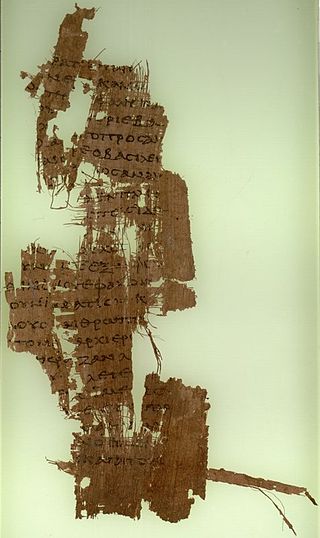
John 19 is the nineteenth chapter of the Gospel of John in the New Testament of the Christian Bible. The book containing this chapter is anonymous, but early Christian tradition uniformly affirmed that John composed this Gospel. This chapter records the events on the day of the crucifixion of Jesus, until his burial.
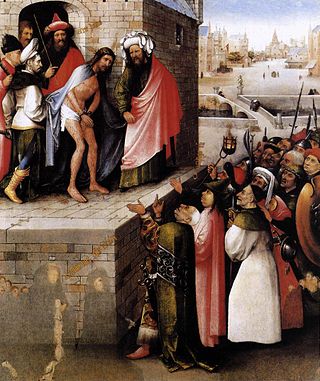
Ecce Homo is a painting of the episode in the Passion of Jesus by the Early Netherlandish painter Hieronymus Bosch, painted between 1475 and 1485. The original version, with a provenance in collections in Ghent, is in the Städel Museum in Frankfurt; a copy is held the Museum of Fine Arts in Boston. The painting takes its title from the Latin words Ecce Homo, "Behold the Man" spoken by the Roman Prefect Pontius Pilate when Jesus is paraded before a baying, angry mob in Jerusalem before he is sentenced to be crucified.

Crown of Thorns' Church, located at 67 Texaco Road, the New Territories, is an Anglican church in Hong Kong. It forms a parish in the Diocese of Western Kowloon under Hong Kong Sheng Kung Hui. The vicar of the parish is Jonathan Chee, who is also the current General Secretary of the Diocese of Western Kowloon.

Papyrus 90, designated by 𝔓90, is a small fragment from the Gospel of John 18:36-19:7 dating palaeographically to the late 2nd century.
Ecce is the Latin word meaning behold. It occurs in the following phrases:

Stabat Mater is a compositional form in the crucifixion of Jesus in art depicting the Virgin Mary under the cross during the crucifixion of Christ alongside John the apostle.

The Maître de Chaource was an unidentified sculptor who worked in the late 15th and early 16th century, in the French town of Chaource. While many works are attributed anonymously to him or his atelier, some scholars have identified Jacques Bachot as the artist. There is certainly circumstantial evidence which points to Bachot; he was a contemporary of the Maître de Chaource and often worked in the same locations and works by Bachot such as that in the church of Saint-Laurent in Joinville, of which fragments are held in the Joinville Town Hall, show great similarities to the work of the Maître de Chaource.

The mocking of Jesus occurred several times, after his trial and before his crucifixion according to the canonical gospels of the New Testament. It is considered part of the passion of Jesus.

The Calvary at Pleyben, dating from 1555, is located in the village of Pleyben in Brittany, northwestern France.
The Calvary at Saint-Thégonnec is part of the enclosure of the parish church of Notre-Dame in Saint-Thégonnec. Erected in 1610 it is the last of the monumental calvaries of Brittany. See also Saint-Thégonnec Parish close.

Ecce Homo is a painting by the Renaissance painter Andrea Mantegna. It is conserved at Musée Jacquemart-André in Paris. It depicts the presentation of Jesus Christ crowned with thorns.

Noli me tangere, also known as Christ Appearing to Mary Magdalene in the Garden, is a c. 1525 painting by Correggio which depicts the noli me tangere interaction between Jesus and Mary Magdalene shortly after the Resurrection. It is currently in the collection of the Museo del Prado in Madrid.
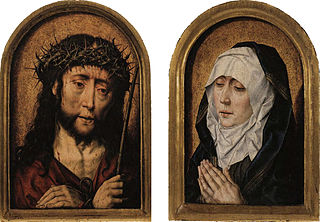
The Ecce Homo and Mater Dolorosa Diptych consisted of two small oil-on-panel paintings usually attributed to the Early Netherlandish artist Aelbrecht Bouts produced between 1491 – 1520. For many years they formed the wings of a hinged devotional diptych, but are now broken apart. Although their exact dating is unknown, the Ecce Homo panel, portraying Jesus bound and crowned with thorns, is thought to have been painted after 1491, while the Mater Dolorosa panel presents the Virgin Mary as Our Lady of Sorrows, and was painted after 1517. Both panels measure 45.5 x 31 cm, although the Mater Dolorosa is slightly larger at 31.1 cm wide. They are in the collection of the Suermondt-Ludwig-Museum, Aachen, Germany, where they are hung alongside each other.
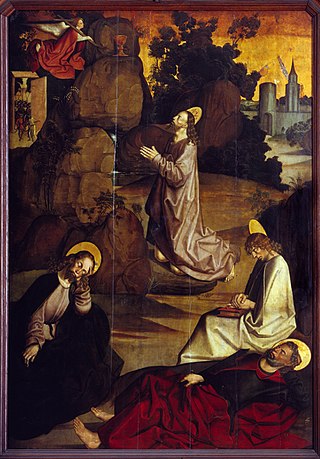
The Litoměřice Altarpiece (1505–1507) was a large altar retable, in all likelihood with two pairs of movable wings and two pairs of fixed ones. From these wings, six panels have survived, two of which are painted on both sides. The movable wings on the left-hand side of the altar are presumed lost. The altar wing depicting Christ on the Mount of Olives belongs to the Diocese of Litoměřice, while the other panels are owned by the Regional Museum in Litoměřice. It is the largest surviving set of panel paintings by an anonymous late Gothic and early Renaissance painter called the Master of the Litoměřice Altarpiece. The altarpiece is part of the permanent collection of the North Bohemian Gallery of Fine Art in Litoměřice.

Saint Catherine Reading is an oil painting by the Italian Renaissance master Antonio da Correggio, painted c. 1530–1532. It is part of the Royal Collection, and is currently on display at Hampton Court Palace, London.

The Ecce Homo is a large oil painting by Titian, signed and dated 1543, which hangs in the Kunsthistorisches Museum in Vienna. It is not to be confused with several smaller compositions by Titian.




